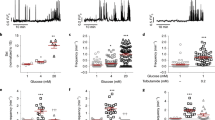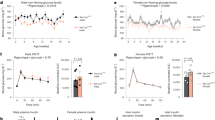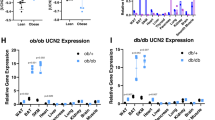Abstract
The peptide hormone urocortin3 (Ucn3) is abundantly expressed by mature beta cells, yet its physiological role is unknown. Here we demonstrate that Ucn3 is stored and co-released with insulin and potentiates glucose-stimulated somatostatin secretion via cognate receptors on delta cells. Further, we found that islets lacking endogenous Ucn3 have fewer delta cells, reduced somatostatin content, impaired somatostatin secretion, and exaggerated insulin release, and that these defects are rectified by treatment with synthetic Ucn3 in vitro. Our observations indicate that the paracrine actions of Ucn3 activate a negative feedback loop that promotes somatostatin release to ensure the timely reduction of insulin secretion upon normalization of plasma glucose. Moreover, Ucn3 is markedly depleted from beta cells in mouse and macaque models of diabetes and in human diabetic islets. This suggests that Ucn3 is a key contributor to stable glycemic control, whose reduction during diabetes aggravates glycemic volatility and contributes to the pathophysiology of this disease.
This is a preview of subscription content, access via your institution
Access options
Subscribe to this journal
Receive 12 print issues and online access
$209.00 per year
only $17.42 per issue
Buy this article
- Purchase on SpringerLink
- Instant access to full article PDF
Prices may be subject to local taxes which are calculated during checkout






Similar content being viewed by others
References
Lin, H.V. & Accili, D. Hormonal regulation of hepatic glucose production in health and disease. Cell Metab. 14, 9–19 (2011).
Leto, D. & Saltiel, A.R. Regulation of glucose transport by insulin: traffic control of GLUT4. Nat. Rev. Mol. Cell Biol. 13, 383–396 (2012).
Ramnanan, C.J., Edgerton, D.S., Kraft, G. & Cherrington, A.D. Physiologic action of glucagon on liver glucose metabolism. Diabetes Obes. Metab. 13 (suppl. 1), 118–125 (2011).
Zhang, Q. et al. Role of KATP channels in glucose-regulated glucagon secretion and impaired counterregulation in type 2 diabetes. Cell Metab. 18, 871–882 (2013).
Taborsky, G.J. Jr., Smith, P.H. & Porte, D. Jr. Interaction of somatostatin with the A and B cells of the endocrine pancreas. Metabolism 27, 1299–1302 (1978).
Caicedo, A. Paracrine and autocrine interactions in the human islet: more than meets the eye. Semin. Cell Dev. Biol. 24, 11–21 (2013).
Patel, Y.C. Somatostatin and its receptor family. Front. Neuroendocrinol. 20, 157–198 (1999).
Salehi, A., Qader, S.S., Grapengiesser, E. & Hellman, B. Pulses of somatostatin release are slightly delayed compared with insulin and antisynchronous to glucagon. Regul. Pept. 144, 43–49 (2007).
Schuit, F.C., Derde, M.P. & Pipeleers, D.G. Sensitivity of rat pancreatic A and B cells to somatostatin. Diabetologia 32, 207–212 (1989).
Unger, R.H. & Cherrington, A.D. Glucagonocentric restructuring of diabetes: a pathophysiologic and therapeutic makeover. J. Clin. Invest. 122, 4–12 (2012).
Braun, M. et al. Somatostatin release, electrical activity, membrane currents and exocytosis in human pancreatic delta cells. Diabetologia 52, 1566–1578 (2009).
Barden, N., Alvarado-Urbina, G., Cote, J.P. & Dupont, A. Cyclic AMP-dependent stimulation of somatostatin secretion by isolated rat islets of Langerhans. Biochem. Biophys. Res. Commun. 71, 840–844 (1976).
Ipp, E. et al. Release of immunoreactive somatostatin from the pancreas in response to glucose, amino acids, pancreozymin-cholecystokinin, and tolbutamide. J. Clin. Invest. 60, 760–765 (1977).
Schauder, P. et al. Somatostatin and insulin release from isolated rat pancreatic islets stimulated by glucose. FEBS Lett. 68, 225–227 (1976).
Patton, G.S. et al. Pancreatic immunoreactive somatostatin release. Proc. Natl. Acad. Sci. USA 74, 2140–2143 (1977).
Hauge-Evans, A.C. et al. Somatostatin secreted by islet delta-cells fulfills multiple roles as a paracrine regulator of islet function. Diabetes 58, 403–411 (2009).
Göpel, S.O., Kanno, T., Barg, S. & Rorsman, P. Patch-clamp characterisation of somatostatin-secreting -cells in intact mouse pancreatic islets. J. Physiol. (Lond.) 528, 497–507 (2000).
Vieira, E., Salehi, A. & Gylfe, E. Glucose inhibits glucagon secretion by a direct effect on mouse pancreatic alpha cells. Diabetologia 50, 370–379 (2007).
Li, C. et al. Urocortin III is expressed in pancreatic beta-cells and stimulates insulin and glucagon secretion. Endocrinology 144, 3216–3224 (2003).
van der Meulen, T. et al. Urocortin 3 marks mature human primary and embryonic stem cell-derived pancreatic alpha and beta cells. PLoS ONE 7, e52181 (2012).
Benner, C. et al. The transcriptional landscape of mouse beta cells compared to human beta cells reveals notable species differences in long non-coding RNA and protein-coding gene expression. BMC Genomics 15, 620 (2014).
Huising, M.O. & Vale, W.W. Corticotropin-releasing hormone and urocortins: binding proteins and receptors. in Encyclopedia of Neuroscience (ed. Squire, L.R.) 231–237 (Academic Press, Oxford, 2009).
Hsu, S.Y. & Hsueh, A.J. Human stresscopin and stresscopin-related peptide are selective ligands for the type 2 corticotropin-releasing hormone receptor. Nat. Med. 7, 605–611 (2001).
Lewis, K. et al. Identification of urocortin III, an additional member of the corticotropin-releasing factor (CRF) family with high affinity for the CRF2 receptor. Proc. Natl. Acad. Sci. USA 98, 7570–7575 (2001).
van der Meulen, T. & Huising, M.O. Maturation of stem cell-derived beta cells guided by the expression of urocortin 3. Rev. Diabet. Stud. 11, 115–132 (2014).
Blum, B. et al. Functional beta-cell maturation is marked by an increased glucose threshold and by expression of urocortin 3. Nat. Biotechnol. 30, 261–264 (2012).
Li, C., Chen, P., Vaughan, J., Lee, K.F. & Vale, W. Urocortin 3 regulates glucose-stimulated insulin secretion and energy homeostasis. Proc. Natl. Acad. Sci. USA 104, 4206–4211 (2007).
Huising, M.O. et al. Glucocorticoids differentially regulate the expression of CRFR1 and CRFR2α in MIN6 insulinoma cells and rodent islets. Endocrinology 152, 138–150 (2011).
Zhang, J., McKenna, L.B., Bogue, C.W. & Kaestner, K.H. The diabetes gene Hhex maintains delta cell differentiation and islet function. Genes Dev. 28, 829–834 (2014).
Artner, I. et al. MafA and MafB regulate genes critical to beta-cells in a unique temporal manner. Diabetes 59, 2530–2539 (2010).
Bale, T.L. et al. Mice deficient for corticotropin-releasing hormone receptor-2 display anxiety-like behaviour and are hypersensitive to stress. Nat. Genet. 24, 410–414 (2000).
Rivier, J. et al. Potent and long-acting corticotropin releasing factor (CRF) receptor 2 selective peptide competitive antagonists. J. Med. Chem. 45, 4737–4747 (2002).
Rorsman, P. & Braun, M. Regulation of insulin secretion in human pancreatic islets. Annu. Rev. Physiol. 75, 155–179 (2013).
Rozzo, A., Meneghel-Rozzo, T., Delakorda, S.L., Yang, S.B. & Rupnik, M. Exocytosis of insulin: in vivo maturation of mouse endocrine pancreas. Ann. NY Acad. Sci. 1152, 53–62 (2009).
Nygaard, E.B., Moller, C.L., Kievit, P., Grove, K.L. & Andersen, B. Increased fibroblast growth factor 21 expression in high-fat diet-sensitive non-human primates (Macaca mulatta). Int. J. Obes. (Lond) 38, 183–191 (2014).
Yang, Y.H. et al. Paracrine signalling loops in adult human and mouse pancreatic islets: netrins modulate beta cell apoptosis signalling via dependence receptors. Diabetologia 54, 828–842 (2011).
Rodriguez-Diaz, R. et al. Alpha cells secrete acetylcholine as a non-neuronal paracrine signal priming beta cell function in humans. Nat. Med. 17, 888–892 (2011).
Xu, E. et al. Intra-islet insulin suppresses glucagon release via GABA-GABAA receptor system. Cell Metab. 3, 47–58 (2006).
Yang, Y.H., Manning Fox, J.E., Zhang, K.L., MacDonald, P.E. & Johnson, J.D. Intraislet SLIT-ROBO signaling is required for beta-cell survival and potentiates insulin secretion. Proc. Natl. Acad. Sci. USA 110, 16480–16485 (2013).
Ohtani, O., Ushiki, T., Kanazawa, H. & Fujita, T. Microcirculation of the pancreas in the rat and rabbit with special reference to the insulo-acinar portal system and emissary vein of the islet. Arch. Histol. Jpn. 49, 45–60 (1986).
Liu, Y.M., Guth, P.H., Kaneko, K., Livingston, E.H. & Brunicardi, F.C. Dynamic in vivo observation of rat islet microcirculation. Pancreas 8, 15–21 (1993).
Murakami, T. et al. The insulo-acinar portal and insulo-venous drainage systems in the pancreas of the mouse, dog, monkey and certain other animals: a scanning electron microscopic study of corrosion casts. Arch. Histol. Cytol. 56, 127–147 (1993).
Bonner-Weir, S. & Orci, L. New perspectives on the microvasculature of the islets of Langerhans in the rat. Diabetes 31, 883–889 (1982).
Stagner, J.I., Samols, E. & Bonner-Weir, S. beta-alpha-delta pancreatic islet cellular perfusion in dogs. Diabetes 37, 1715–1721 (1988).
Samols, E. & Stagner, J.I. Islet somatostatin–microvascular, paracrine, and pulsatile regulation. Metabolism 39, 55–60 (1990).
Nyman, L.R. et al. Real-time, multidimensional in vivo imaging used to investigate blood flow in mouse pancreatic islets. J. Clin. Invest. 118, 3790–3797 (2008).
Benninger, R.K., Zhang, M., Head, W.S., Satin, L.S. & Piston, D.W. Gap junction coupling and calcium waves in the pancreatic islet. Biophys. J. 95, 5048–5061 (2008).
Ravier, M.A. et al. Loss of connexin36 channels alters beta-cell coupling, islet synchronization of glucose-induced Ca2+ and insulin oscillations, and basal insulin release. Diabetes 54, 1798–1807 (2005).
Head, W.S. et al. Connexin-36 gap junctions regulate in vivo first- and second-phase insulin secretion dynamics and glucose tolerance in the conscious mouse. Diabetes 61, 1700–1707 (2012).
Jørgensen, M.C. et al. An illustrated review of early pancreas development in the mouse. Endocr. Rev. 28, 685–705 (2007).
Herrera, P.L. et al. Embryogenesis of the murine endocrine pancreas; early expression of pancreatic polypeptide gene. Development 113, 1257–1265 (1991).
Gromada, J., Franklin, I. & Wollheim, C.B. Alpha-cells of the endocrine pancreas: 35 years of research but the enigma remains. Endocr. Rev. 28, 84–116 (2007).
Unger, R.H. & Orci, L. Paracrinology of islets and the paracrinopathy of diabetes. Proc. Natl. Acad. Sci. USA 107, 16009–16012 (2010).
Huising, M.O. et al. CRFR1 is expressed on pancreatic beta cells, promotes beta cell proliferation, and potentiates insulin secretion in a glucose-dependent manner. Proc. Natl. Acad. Sci. USA 107, 912–917 (2010).
Huising, M.O. et al. Residues of corticotropin releasing factor-binding protein (CRF-BP) that selectively abrogate binding to CRF but not to urocortin 1. J. Biol. Chem. 283, 8902–8912 (2008).
Asfari, M. et al. Establishment of 2-mercaptoethanol-dependent differentiated insulin-secreting cell lines. Endocrinology 130, 167–178 (1992).
Taniguchi, H. et al. A resource of Cre driver lines for genetic targeting of GABAergic neurons in cerebral cortex. Neuron 71, 995–1013 (2011).
Herrera, P.L. Adult insulin- and glucagon-producing cells differentiate from two independent cell lineages. Development 127, 2317–2322 (2000).
Srinivas, S. et al. Cre reporter strains produced by targeted insertion of EYFP and ECFP into the ROSA26 locus. BMC Dev. Biol. 1, 4 (2001).
Reubi, J.C. et al. SST3-selective potent peptidic somatostatin receptor antagonists. Proc. Natl. Acad. Sci. USA 97, 13973–13978 (2000).
Cescato, R. et al. Design and in vitro characterization of highly sst2-selective somatostatin antagonists suitable for radiotargeting. J. Med. Chem. 51, 4030–4037 (2008).
Dobin, A. et al. STAR: ultrafast universal RNA-seq aligner. Bioinformatics 29, 15–21 (2013).
Quinlan, A.R. & Hall, I.M. BEDTools: a flexible suite of utilities for comparing genomic features. Bioinformatics 26, 841–842 (2010).
Anders, S. & Huber, W. Differential expression analysis for sequence count data. Genome Biol. 11, R106 (2010).
ENCODE Project Consortium. An integrated encyclopedia of DNA elements in the human genome. Nature 489, 57–74 (2012).
Heinz, S. et al. Simple combinations of lineage-determining transcription factors prime cis-regulatory elements required for macrophage and B cell identities. Mol. Cell 38, 576–589 (2010).
Brazeau, P. et al. Hypothalamic polypeptide that inhibits the secretion of immunoreactive pituitary growth hormone. Science 179, 77–79 (1973).
Vale, W., Rivier, J., Ling, N. & Brown, M. Biologic and immunologic activities and applications of somatostatin analogs. Metabolism 27, 1391–1401 (1978).
Vaughan, J.M. et al. Detection and purification of inhibin using antisera generated against synthetic peptide fragments. Methods Enzymol. 168, 588–617 (1989).
Padmanabhan, K., Eddy, W.F. & Crowley, J.C. A novel algorithm for optimal image thresholding of biological data. J. Neurosci. Methods 193, 380–384 (2010).
Acknowledgements
We dedicate this work to the memory of Wylie W. Vale (W.W.V.), who co-discovered both somatostatin (in 1973) and urocortin 3 (in 2001) and who would have been delighted by their participation in the same feedback loop. We acquired images at the Waitt Advanced Biophotonics Center at the Salk Institute and at the Veterinary Medicine Advanced Imaging Facility and Plant Biology core facilities at University of California Davis. We acknowledge N. Justice (University of Texas Health Science Center, Houston, Texas, USA) for generating the BAC construct used to generate the Crhr2α−mCherry−Cre reporter line. We acknowledge J. Vaughan for iodination of tracers and H. Park, K. Tigyi and S. Dólleman for their excellent assistance with various aspects of these studies. We thank R. Yang and K. Nakamura at Dexcom Inc. for their assistance in unblinding CGM data at the conclusion of the CGM experiment. We performed this research with the support of the Network for Pancreatic Organ Donors with Diabetes (nPOD), a collaborative Type 1 diabetes research project sponsored by the Juvenile Diabetes Research Foundation (JDRF). We obtained human islets through the integrated islet distribution program (IIDP). M.O.H. is the recipient of a Career Development Award of the JDRF. These studies were supported by grants 17−2012−424 and 2−2013−54 from the JDRF (to M.O.H.), P01−DK026741 from the US National Institutes of Health/National Institute of Diabetes and Digestive and Kidney Diseases (to W.W.V.) and the Clayton Medical Research Foundation, Inc. (to M.O.H. and W.W.V.) The nonhuman primate studies at the Oregon National Primate Research Center (ONPRC) Obese Resource were funded by US National Institutes of Health/Office of the Director grant P51 OD011092 (to K.L.G.). We first reported these findings at the Emerging Concepts and Targets in Islet Biology meeting in Keystone, Colorado on April 8, 2014 and the 73rd and 74th Scientific Sessions of the American Diabetes Association in Chicago on June 23, 2013 and San Francisco on June 16, 2014, respectively.
Author information
Authors and Affiliations
Contributions
T.v.d.M. and M.O.H. validated the mouse models generated over the course of this study and designed all mouse experiments. T.v.d.M., E.C., A.E.H., A.Z. and M.O.H. performed mouse experiments. T.v.d.M., C.J.D., A.E.H. and M.O.H. performed many islet isolations. C.J.D. performed all insulin and somatostatin hormone measurements and coordinated the receipt of human islets. E.C. and M.O.H. designed, performed and analyzed the continuous glucose monitoring experiment. C.C.-Z. and M.O.H. performed bioinformatics analyses. T.v.d.M. and M.O.H. conducted immunolabeling and acquired all images. M.W.A. performed super-resolution structured illumination microscopy and supported image acquisition and analysis. L.D.P. and K.L.G. designed and conducted the nonhuman primate studies and provided the histological material used in this study. M.O.H. conceived the study, was responsible for its overall design and planning and wrote the article together with T.v.d.M.
Corresponding author
Ethics declarations
Competing interests
The authors declare no competing financial interests.
Supplementary information
Supplementary Text and Figures
Supplementary Figures 1–8 & Supplementary Tables 1–5 (PDF 13484 kb)
Rights and permissions
About this article
Cite this article
van der Meulen, T., Donaldson, C., Cáceres, E. et al. Urocortin3 mediates somatostatin-dependent negative feedback control of insulin secretion. Nat Med 21, 769–776 (2015). https://doi.org/10.1038/nm.3872
Received:
Accepted:
Published:
Issue Date:
DOI: https://doi.org/10.1038/nm.3872
This article is cited by
-
Paracrine signalling by pancreatic δ cells determines the glycaemic set point in mice
Nature Metabolism (2024)
-
Readily releasable β cells with tight Ca2+–exocytosis coupling dictate biphasic glucose-stimulated insulin secretion
Nature Metabolism (2024)
-
USP7 controls NGN3 stability and pancreatic endocrine lineage development
Nature Communications (2023)
-
Single-cell RNA sequencing combined with single-cell proteomics identifies the metabolic adaptation of islet cell subpopulations to high-fat diet in mice
Diabetologia (2023)
-
Pancreatic β-cell heterogeneity in adult human islets and stem cell-derived islets
Cellular and Molecular Life Sciences (2023)



